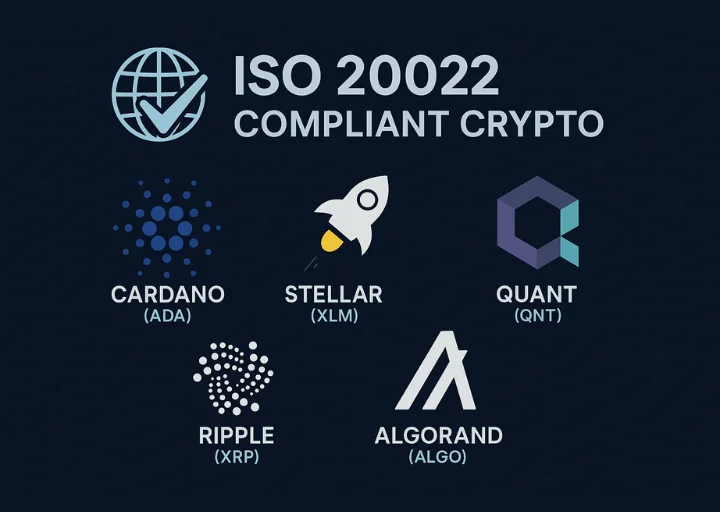List of ISO 20022 Compliant Crypto
Cryptocurrencies have become popular alternative money tools; however, investors think about volatility and that sort of thing. Also, digital assets face challenges in interfacing with traditional financial systems. Thus, the entry of ISO 20022 into the new standard for financial messaging brings a ray of hope to these problems. The most eminent cryptos are appearing as ISO 20022-compliant cryptos, indicating the start of a movement toward ISO adoption on the blockchain side.
ISO 20022 stands for the standardization and interoperability in the crypto economy to facilitate communication among various financial stakeholders. Hence, let us see how this standard is influencing the world of cryptocurrencies and which cryptocurrency forms have been accepted into it.
Table of Contents:
1. Discovering the Significance of ISO 20022 for Cryptocurrencies
2. Understanding ISO 20022 Compliance in Cryptocurrencies
3. Investigating a List of the Most Well-Known ISO 20022 Compliant Cryptocurrencies
3.1 Cardano (ADA)
3.2 Stellar (XLM)
3.3IOTA (MIOTA)
3.4 Quant (QNT)
3.5 Ripple (XRP)
3.6 Algorand (ALGO)
4. Final Thoughts

Discovering the Significance of ISO 20022 for Cryptocurrencies
ISO 20022 is a single global financial messaging standard that aims to simplify data exchange between financial systems and institutions such as SWIFT. ISO 20022 seeks to consolidate the numerous different messaging formats with a global standard protocol. Financial institutions across the globe can, through ISO 20022, simplify operations, minimize messaging complexity, and enhance data correctness.
When examining what it is for a digital currency to be ISO 20022-compliant, it is worthwhile to appreciate that the standard refers to the way financial information is structured and conveyed. Cryptocurrencies that embrace this standard place themselves for easier inclusion in traditional financial systems. The compatibility fortifies the bridge between traditional banking and decentralized finance.
Standardization with ISO 20022 also has the potential to lower fraud and error rates in financial communication, further building security and trust in the crypto environment. It can also contribute to quicker, more streamlined transactions and lower costs, major benefits adding to increased adoption of cryptocurrency.
Understanding ISO 20022 Compliance in Cryptocurrencies
So, before we jump to the list of all ISO 20022 compliant cryptocurrencies, let us see what compliance means in this regard. It should be understood that the token per se is non-compliant; it is the technology or platform upon which the token rests that is compliant with ISO 20022 messaging standards. For instance, the Ripple payment gateway may interface with SWIFT using ISO 20022 standards.
ISO 20022 acts as a sort of interface for the simplified transfer of financial data from one network to another, thereby offering interoperability within the cryptocurrency domain. More and more blockchain projects are now employing the messaging standards: so more and more cryptocurrencies adhering to ISO 20022 will, therefore, be realized. These kinds of initiatives act as a very important step forward in bringing together the worlds of digital and real finance so that digital assets become available globally and accepted everywhere.
Investigating a List of the Most Well-Known ISO 20022 Compliant Cryptocurrencies
Enabling cryptocurrency systems to conform to the ISO 20022 standard in effect sets the stage for acceptance and inclusion of these technologies into conventional financial systems. The standard enhances trust and fosters an environment capable of exchange, facilitating digital currencies in becoming a concrete element of mainstream finance. Below are some of the cryptocurrencies that comply with ISO 20022, reflecting the future benefits of compliance within digital finance.
Cardano (ADA)
Cardano (ADA) is a strong blockchain network that has a research-based development strategy. It provides a secured and environmentally sustainable environment for financial use cases. ADA, Cardano’s native token, is another leading cryptocurrency adopting ISO 20022 for easier integration with legacy financial systems.
In furtherance of complete interoperability between legacy financial systems and their advanced blockchain functionalities, the Cardano blockchain utilizes the ISO 20022 standard. This integration allows banks to effortlessly embed Cardano technology, with much of the onboarding of traditional financial institutions henceforth becoming an easy process.
Major benefits of Cardano under ISO 20022 are offering support for intricate smart contracts and a novel consensus algorithm. Its burgeoning DeFi ecosystem and broadening dApp platform set it up for greater institutional adoption.
Stellar (XLM)
Stellar (XLM) is another well-known project implementing ISO 20022, aiming to provide low-cost and quick cross-border payments. Its vision is to bring together individuals, banks, and payment systems to make international transactions efficient through its native coin, XLM.
Adoption of ISO 20022 enables Stellar to interface with established financial institutions and legacy systems. XLM’s most attractive aspect is Stellar’s emphasis on financial inclusion and access.
With attributes such as its consensus protocol and integrated decentralized exchange, Stellar is best positioned to cater to financial institutions in need of lower-cost and faster payment options while enhancing global financial access.
IOTA (MIOTA)
IOTA (MIOTA) has taken a distinct position by focusing on the Internet of Things (IoT) framework. It utilizes a directed acyclic graph (DAG) architecture called the Tangle, enabling secure and scalable transactions, perfect for machine-to-machine communication.
With ISO 20022 compatibility, IOTA is able to securely and in a standardized format transfer information between IoT devices. This imparts it with greater compatibility with major IoT frameworks so that it eliminates current silos and potentiates much innovation.
Among its main irregularities, we find IOTA’s feeless microtransactions, its quantum-resistant cryptography, and its lightweight architecture-that is, the one suitable for IoT integration under the ISO 20022 standard.
Quant (QNT)
Quant (QNT) is one of the top names in blockchain interoperability. It makes use of the Overledger protocol to interconnect various blockchains and enable smooth data exchange between networks.
By implementing ISO 20022, Quant becomes more compatible with legacy financial systems and thus easier to integrate decentralized and centralized infrastructures. It allows secure communication among different networks while encouraging decentralized control.
Quant’s strong suit is in its interoperability protocol and capability to host enterprise-scale applications, and so it’s a good fit for financial institutions that want to adopt blockchain technology through standardized communications.
Ripple (XRP)
Ripple (XRP) is one of the most recognized digital currencies, known for changing the way cross-border payments are made. As the Ripple network’s native currency, XRP makes quick and inexpensive transactions between worldwide financial institutions possible.
The emphasis of Ripple on converging with legacy systems places XRP in a solid position for ISO 20022. The consensus algorithm of the network enables speedy transaction processing up to 1,500 transactions per second, and its collaborations with top banks and financial institutions place it firmly in position for leadership in future digital finance.
Adoption of ISO 20022 allows XRP to act as a bridge between fiat currencies, promoting liquidity and settling faster on a worldwide level.
Algorand (ALGO)
Algorand (ALGO) is a flexible and highly performant blockchain envisaged for embracing use cases, both financial and non-financial. Its consensus algorithm is very fast and efficient, while its platform supports dApps and smart contracts.
Since Algorand incorporated ISO 20022, it has been able to align close with traditional financial infrastructures, getting more institutional adoption. Such harmonization does not only build trust but also invites innovation developers and entities seeking a trusted blockchain platform.
With compatibility to ISO 20022, Algorand makes itself an even more attractive solution for organizations to close the gap between mainstream finance and blockchain innovation.
Final Thoughts
The increasing number of ISO 20022-compliant cryptocurrencies demonstrates the revolutionary potential of following standardized financial messaging. ISO 20022 was created to standardize and simplify communication between global financial institutions, and now it’s being used to bridge the divide between digital assets and legacy banking.
Such projects as Stellar are built with ISO 20022 integration in mind, whereas projects like Ripple and Quant are actually driving interoperability and cooperation with traditional systems. As this standard’s adoption increases throughout the crypto community, it will create new opportunities for inter-system integration, greater trust, and greater global acceptance.

CEO and Co-Founder